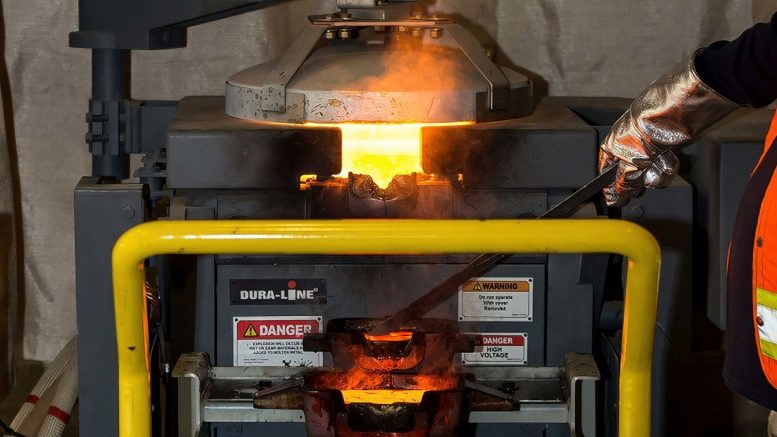Pure Gold Mining (TSXV: PGM; US-OTC: LRTNF) management was fielding uncomfortable questions from concerned shareholders during a conference call Tuesday following the company’s release of what investors termed a ‘torturous’ second-quarter operations update and financial report.
While the company cited an expected “significant improvement in production” in the third quarter, it says it remains on track to complete an updated mine plan and prefeasibility study by year-end. However, the extreme focus on near-term production does little to ease shareholder apprehension over the asset’s muddled longer-term outlook.
Pure Gold said output fell during the second quarter due in part to cash-preservation measures taken by the company while negotiating financing agreements. For the three months, the PureGold mine in Ontario’s famed Red Lake District saw a reduction in workforce, and the mill was operating at only 50% capacity. Main ramp development remained halted in favour of near-term production.
Mining totalled 40,551 tonnes of ore (an average of 445 tonnes per day) and 85,267 tonnes (an average of 471 tonnes per day) for the first half of 2022. Overall, Pure Gold produced 3,509 oz. during the period and 8,244 oz. for the first half of 2022.
While the company saw a 30% reduction in costs compared to the first quarter, it still booked an operating loss of $18.5 million and $41.9 million for the quarter and the half, respectively. The net and comprehensive losses totalled $20.8 million and $42.2 million. All figures were higher than their comparative periods in 2021.
During the analyst conference call, David Smith of the Morgan Report had some pointed questions for president and CEO Mark O’Dea, who runs the Oxygen Capital group of companies, and took over management from Troy Fierro in April.
“Mark, you may remember about a year ago, you and I had tremendous talks, and I listened to you as someone who has been able to pull off this concept successfully several times before,” he said in framing his question.
He said it contrasted with the current message. “The same goes for the share price; first, US$4 was the best place to take a profit on the way down to US$2, to US7¢. I’m just wondering how someone with your capability, who has done this before, to build this as one of the best 94% of projects out there, is going to put out such a torturous circumstance?” the investor wanted to know. “It’s the most torturous thing I’ve read in 25 years.”

Oxygen Capital founder and Pure Gold Mining President and CEO Mark O’Dea. Credit: Henry Lazenby.
Smith wanted to know what fundamental thing he was missing between months of little to no news flow from the company and basic things being overlooked — like drilling a stope that has low yield and paying too much for a camp. “This project has gone through several management teams, and Eric Sprott, a sharp cookie, is even involved. How can we all get so far off base on this? Am I missing something really, really fundamental and important?”
O’Dea responded by saying: “I guess the short answer is, Mother Nature surprised us in a lot of ways at the beginning of our mine life here,” O’Dea said. “We started life in the McVeigh deposit. It’s turned out to be geometrically more challenging than we’d anticipated and required a lot more drilling than we thought it needed. We paid the price for that, we all have.
“It’s required a whole new assessment in terms of how to approach this operation and has become a lot more drill intensive. We’ve had to retool our team and build a whole new operating system around success here.”
While O’Dea said the process has “taken a lot more time than any of us feel comfortable about,” he said the team is optimistic that the deposit can and will be mined successfully.
White-knuckle ride
The Vancouver-based miner poured its first gold at the end of 2020 and announced the start of commercial production in August 2021. Its PureGold mine, however, has struggled to consistently produce at its nameplate capacity of 800 tonnes a day, despite mill upgrades that intended to increase capacity to 1,000 tonnes a day.
Construction delays, lousy scheduling, problems with equipment, and “strategic misalignments,” were cited by the miner to explain production shortfalls. The mounting issues triggered a change in leadership early this year.
In July, the company kicked off a strategic review process that could involve a potential sale or merger. It also has in July re-arranged financing with its lender Sprott Resource Lending Corp., which provided around $12 million of additional liquidity within the next 15 months.
The two firms agreed on temporary reductions to the minimum cash and minimum working capital ratio covenants to US$5 million for the months ending June 30 and July 31, 2022.
Production at the mine has continued to fall, with head grades falling to 4.27 grams gold per tonne in the quarter ended Mar. 31. For the second quarter, the head grade had plunged to 2.4 grams gold. The company has suspended production guidance in the interim.
Another factor affecting second quarter production was significant turnover and workforce shortages in key areas like long hole drilling, mobile mechanics, and technical staff.
In a note to clients, Laurentian Bank Securities Equity Research analyst Barry Allan pointed out the company was in serious financial trouble. “As of June 30, 2022, PGM held only about $12.7 million in cash following a $16.6 million consumption in cash flow for the quarter. Additionally, PGM’s working capital came in at a deficit of about $24.5 million and its debt-to-equity ratio in Q2 sat at 2:1 – all after a $31.1 million equity raise in May 2022.
“PGM continues to claim they are a quarter away from being cash flow neutral; however, it appears they are out of options as their cash reserves are depleted and difficult market conditions make an equity financing very dilutive. SRK is currently developing a new LOM plan for Q4/22, but Q4/22 may be too late given the poor state of the balance sheet,” wrote the analyst.
How much gold?
Another private investor pressed management for more clarity around production guidance.
O’Dea responded by pointing to the projections provided in the news release, which don’t give a clear picture of what to expect.
“We provided some tonnage and grade ranges that get you to the end of the third quarter. And we’re looking to get that in our back pocket and then come back to everyone with some near-term production guidance as the third quarter wraps up,” said O’Dea.
Pure Gold has guided for ore throughput for the third quarter to average between 775 to 875 tonnes per day at 4 to 5 grams gold per tonne. The company has also guided for expected mill recovery of 95% and operating plus sustaining capital costs of about $9.5 to $10.5 million.
IKN News sheds some more light on the math around the provided projections.
“Run the math on those criteria and you’ll work out that at the minimum guided throughput and grade, the PureGold mine produces around 8,500 oz. in 3q22 and at US$1,800 per oz., that’s US$15 million or so,” said the daily newsletter’s, Otto Rock.
“Or if your glass is half full and you assume 875 tonnes per day and 5 grams gold per tonne, the projected gold production would be around 12,000 oz. gold and the gross revenues would be U$21.65 million. So, if they guide costs at $10 million, they’ll make a margin and that’s a start.”
Resources cut
As part of its turnaround strategy, Pure Gold has released an updated resource estimate for its namesake operation, reporting 20% fewer ounces in the resource categories. A new technical report completed by SRK sees the mine’s global resource base falling to 2 million oz. from 2.5 million oz. and the average grade reduced to 7.2 grams gold per tonne from 8.7 grams per tonne.
Breaking that down by category, total indicated resources now stand at 6.9 million tonnes grading 7.4 grams gold for 1.7 million oz. gold and inferred resources measure 1.8 million tonnes grading 6.3 grams gold for 366,200 oz. gold.
While the global resource decline is material, Laurentian analyst Allan had been concerned the actual drop would be worse, given SRK’s history of taking an overly conservative approach to revised resource estimates, he wrote a in a research note on Aug. 10.
Although a revised mine plan for the ailing operation is yet to be completed, the bank’s internal model shows a reduction in recoverable gold to 1.3 million oz. from 1.9 million oz. previously.
“In our opinion, PGM falls from being a 150,000 oz. per year producer to a 120,000 oz. per year producer (in 2026 at an indicated capacity of 1,000 tonnes per day),” said Allan.
Pure Gold’s COO, Terry Smith said the SRK resource model will “help light the way” to grow production in the upcoming prefeasibility study.
Pure Gold is also spinning things more optimistically in terms of the third and fourth quarter outlook. It said it has just completed a record gold pour and was looking towards another record pour soon, capitalizing on the new resource model for long-term planning; a revamped short-term planning process to drive execution; a lower operating cost base to generate cash flow; and an emerging culture of safety and performance, according to Smith.
Going forward, Pure Gold will focus more on the higher-grade and less structurally complex Austin and South Austin Zones than the McVeigh deposit. Austin and South Austin will contribute about 65% to overall third-quarter production, compared to about 30% since production began. “We expect higher overall production levels as Austin and South Austin contribute still more and McVeigh contributes less,” said O’Dea.
Pure Gold shares have lost 90% of their value over the past 12 months. At press time, the equity was trading at 12¢ per share, giving Pure Gold a market capitalization of $87.4 million.


Be the first to comment on "Pure Gold management faces the music following ‘torturous’ Q2 report"